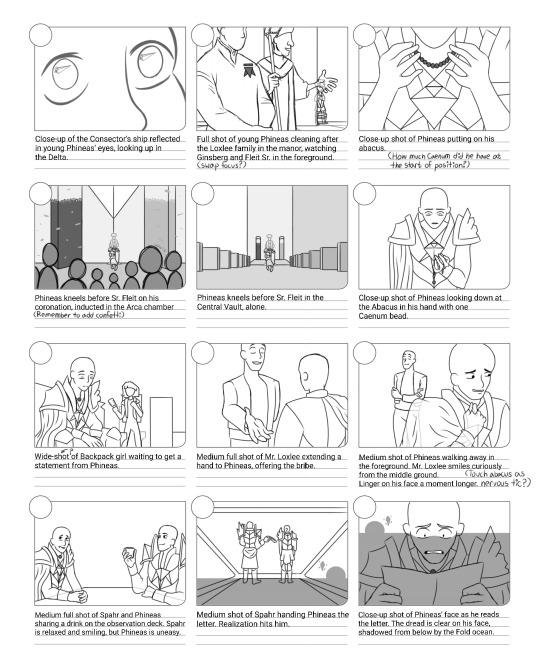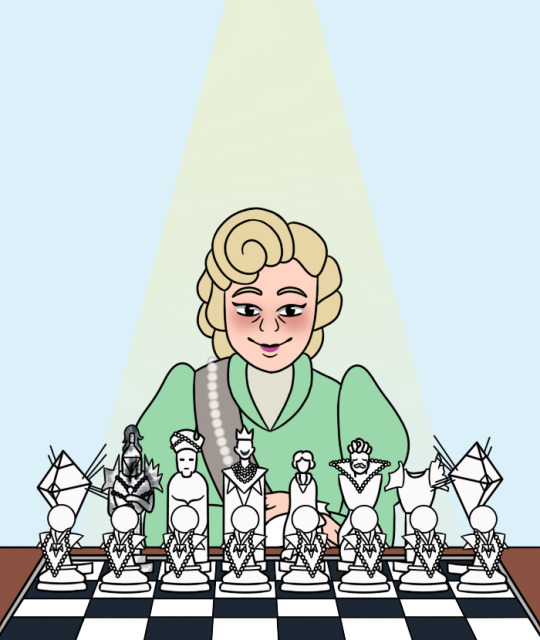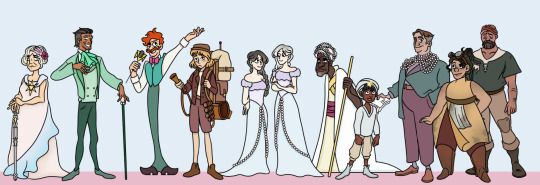#Milton Fleit Sr.
Text

First half of the storyboard for the Midst animatic I am working on. Due to real life difficulties, accomplishing this much has taken several months. I hope to finish the storyboard before the series is over, if not the animatic itself.
#midst#midst podcast#phineas thatch#hieronymous loxlee#Demarin Ginsberg#Milton Fleit Sr.#Jonas spahr#storyboard
6 notes
·
View notes
Note
Like, where are Milton Fleit Jr.'s parents? What is that whole generation of the Fleit family between Senior Notary Sr. and Jr. up to?
🔮: Huh, that IS weird, right? If there was ever going to be information about such a topic, it would probably be found in Season 3.
50 notes
·
View notes
Text
One thing (among many) that Midst does incredibly well is that the narrators use character death as a narrative tool expertly. Every death in the series does something and each death tends to have a narrative weight that's proportional to the narrative weight the deceased character had while alive.
Stationary Hill's Postmaster and Agatha Ledge are both minor characters whose deaths, while they are felt by the characters who knew them in universe, mostly serve to highlight the danger the other characters find themselves in, as the Moon Tearror hits Stationary Hill and the remaining Breach members (and Jonas Spahr) are plummeting through a razor-sharp mica field respectively. Meryl Concord is likewise a fairly minor character whose death serves both to mirror her brother Atticus's* (more on him later) and usher in the final phase of the conflict against Weepe by showing the how dangerous the heaving mass of tearror unleashed from his puppeteered body is. All these deaths serve to establish the lethal stakes of the situations each death occurs in, but are ultimately not dwelt upon too long by the narrative. This works because these are minor characters; they had little enough presence that the story can swiftly move on in their absence without feeling like a disservice to them.
Milton Fleit Sr. and Imelda Goldfinch are both antagonistic characters who ultimately die fairly ignoble deaths that the narrative doesn't dwell too long on, largely because, as the finale itself points out in regards to Imelda, none of the living characters we follow care enough about either of them to dwell on their deaths. But despite his both their deaths are heavily symbolically loaded. Milton Fleit Sr. dies in the same moment that Valor dies and the Trust begins bleeding out. Imelda Goldfinch dies in the moment that all her scheming to get Weepe in control of the Trust because she believes the Trust needs a man like him to lead it comes to nothing because Weepe at this point is a dying, broken man aggressively lashing out at everything around him. The narrative spends little time dwelling on the deaths of the characters themselves, and that works despite how important of a character Imelda in particular was, because it serves to highlight that ultimately, both of their lives, spent devoted heart and soul to the Trust, came to absolutely nothing because the Trust died with them.
Atticus Concord, Fuze Peabody, and Kozma Lazlo are important secondary characters whose deaths end up as catalysts for major plot developments later in the story. Atticus, in his attempt to blackmail Weepe and Saskia over the Black Candle Cabaret's role in the Breach route, ended up both murdered by Weepe and providing him with the means to facilitate his raise into the upper echelons of Trust society (in the form of his meticulously documented notes on every Breached employee of the Cabaret). His death is also the reason Meryl enters the story and avenging him is the reason she stabs Weepe and in doing so directly shapes the final confrontation between Midst's three protagonists. Fuze's murder after informing Phineas and Spahr via letter that he had information about the Trust's most infamous murder case resulted in Phineas' attack on Sherman in the Cabaret, Phineas impulsively running off after Tzila in a desperate bid to avoid Spahr saying he'd failed, Sherman selling Lark out to the Trust, and the Trust's focus throughout season 3 on finding Lark in order to solve to the economic crisis caused by Midst's moon exploding. Kozma's death at the hands of Weepe after threatening the Upper Trust is the trigger for the Breach's attack on the Central Vault, which is what ushers in the final act of the story. It is also the moment in which we learn that before he was Moc Weepe that character was a Fold Baron whom the other Barons, spearheaded by Kozma, attempted to murder by throwing him into the Fold Depths in a mica sarcophagus.** These characters were all major drivers of certain aspects of the plot in life, and they remained so in death, with each one of their demises having ripple effects that lasted through to the end of the story. The deaths of all three of these characters were also very heavily telegraphed. Weepe threatens Atticus on their first meeting with death if he's fucking with the Cabaret, Fuze is introduced as a man who is going to be murdered before too long, and Kozma's death is foreshadowed in the episode icon for "Baron", which shows someone's red blood in Weepe's pump apparatus.
The two most plot-central characters to die***, Moc Weepe and Saskia del Norma likewise had their deaths telegraphed to the audience in advance of them actually happening, with the narrators describing Weepe's happenstance first meeting with Imelda Goldfinch as spelling his doom and the way Saskia looks at Sherman, and tells him to go on without her at the end of "Shindig" signalling that something major is happening with her other body in the Highest Light and that whatever it is is not good for her. These deaths also were both given a lot of narrative breathing room. Saskia's death is in many ways the primary narrative subject of not only "Ghosts", the episode in which she has her final confrontation with Weepe before expiring, but also "Shindig", the episode that showed us why she made the choice to shred the remaining explosive beads at the cost of one of her bodies (and eventually her life). This post here is a great breakdown of how key an episode "Shindig" is in understanding Saskia and her motivations at the end. As mentioned above the narrators called Weepe's doom as early as season 1, and in many ways the entire series was a slow build towards his demise, especially after Imelda's actions (and Spahr's inactions) in "Inside" lead to a drastic worsening of his Fold condition. Weepe's immanent death hangs over "Ghosts" as much as Saskia's does, as Mother Trauma says, Saskia doesn't have long, but neither does Weepe. The finale also takes time out of the frenetic pacing of the final battle to have a quiet moment with the last remaining exhausted flicker of Moc Weepe, to show that above all else he is just tired and wants to finally rest. These deaths are given a lot of time to sit and settle because these are central characters, and their deaths have as much narrative weight as their lives do. As well, in Saskia's case, she remains central to the plot after her death, as it is what drives Weepe into the despair fueled rampage that he spends the final two episodes of the show in, and it is in her name that the Stationarians charge Weepe and the Company.
Every character who dies in Midst has their death count for something, in a narrative sense, but how much that death is doing is proportional to the weight the character had in the narrative while alive, and that helps make each death feel appropriate, narratively earned and appropriately impactful.
*Meryl Concord is Weepe's last onscreen victim, just as her brother is his first, and they both die the same way, being horribly dissolved by the Fold strain in his blood.
**The word "sarcophagus" is also used to describe what Lark creates to contain the leaking Fold from Weepe's corpse. Moc Weepe began and ended in a sarcophagus of glittering material, the first which excited Fold and the second which calmed it.
***It's debatable whether or not Lark's fate counts as "dead", as it seems she more became a permanent part of the Fold than anything else. Regardless, the pattern still applies, Lark's acceptance of the Fold and it's acceptance of her has been a part of her arc from the beginning of the show, and the moment where she joined it was another quiet moment in an action packed finale that was allowed to breathe and settle with the audience.
233 notes
·
View notes
Text
it sort of got lost in all the everything that was happening but a line from this episode that i really really loved was when milton fleit sr. said "the Breach destroyed my daughter." this man's daughter and son-in-law were killed in cold blood by the Prime Consector of the Trust but of-fucking-course this is how he thinks about it. he's continued to hobnob at the same parties as olga costigan in the years following, after all! "the breach destroyed my daughter", indeed. like it wasn't even her own choice! that's a truth he just can't face!
#magdalyn fleit i'm dying to know more about you and what your life was like#and rest assured if we don't get that information i will! make it up.#midst#midst podcast#midst spoilers
63 notes
·
View notes
Text
I LOVE accusing every single character of being a Breach collaborator without ANY regard for whether it makes sense or whether it's likely. Hell, it's almost better if it makes absolutely no sense and isn't all that likely, since this is entirely for my own amusement. But, some of them do make at least a bit of sense, and that's also so fun to think about. Ever since the Hieronymous drop, I've just been randomly pointing fingers at any character we don't yet know either way, and coming up with reasons that would be interesting or funny or how it might work, for funsies.
Jedediah Pom? He's extremely well-placed as a member of the media, and I'm constantly suspicious of how closely he watches everything, even with considering his job. Backpack? She always seems to be in the oddest places, and I would not be surprised if information was coming through her—knowingly or unknowingly. Kozma? Would fit in with her (horrifying) propensity to "collect" people and could function as a kind of first-look deal (awful).
Agatha Ledge? I feel like the gap between her Incendiary Imaging Device and Breach stuff can be very small if you lay the cards down right, no, I cannot explain (but a mad scientist-type who changes sides because they're unhappy with their pay or access is always great). One of Imelda's brunch group (Penny, Gert, Lucille, Desiree, Maeve)? The BETRAYAL! Olga Costigan? Extremely unlikely, but it would make Spahr's life worse in a specific way that is funny to only me. Gretel? Actually, this would be pretty great because she worked directly under Spahr, and also this would make Spahr handing off Hieronymous to her at the hotel really funny.
Arno Delagny? Maybe we should be questioning why so many former employees of the Delagney Hotel at the Vantage have Breached. Imogen Loxlee, Milton Fleit Sr.? Just imagine the chaos of that for a second. The Miravette twins? They clearly need something better to do with their time and sedition might be it. Melinda Crowne? She IS a friend of Sherman's and Emmet's mother. Spahr's parents that I assume he has? Again, would stress him out so much in a way that is funny to me specifically. Speaker Corsovia, Ambassador Isadore Riley? We don't know anything about either of them for this to mean anything, so why not.
It's genuinely so fun for me to just be constantly like: today's Breach collaborator is [spins wheel]
48 notes
·
View notes
Text

"Making Moves" (1/2)
#midst#midst podcast#midst spoilers#jonas spahr#milton fleit sr#moc weepe#imogen loxlee#jedediah pom#the trust#imelda goldfinch
20 notes
·
View notes
Text
I'm curious to see where the Midst community's heads are at regarding this overarching mystery!
We do not have all the pieces yet, but it's safe to assume that a significant amount of the clues were present in seasons 1 and 2. It goes without saying that this is the mystery at the heart of this storyline, and there are no shortage of suspects to choose from.
(Excluding the final entry, this list has been set in alphabetical order so as to avoid personal biases)
#midst#midst podcast#midst theories#atticus concord#ex-consector costigan#hieronymus loxlee#imelda goldfinch#kozma laszlo#lark#Maximilian Loxlee#milton fleit sr#moc weepe#The Mothers
17 notes
·
View notes
Text

My old Trust character design line-up. Both the designs for Jedediah Pom and Backpack are outdated, but I'd like to imagine that this design is what Jedediah looked like back when he first became a broadcaster.
From left to right: Imogen Loxlee, Hieronymus Loxlee, Jedediah Pom, Backpack, The Miravette Twins, Milton Fleit Sr., Milton Fleit Jr., Mr. Meshkala, Ms. Ledge, Demarin Ginsberg
#midst#midst podcast#midst fanart#character design#Imogen loxlee#Hieronymus Loxlee#jedediah pom#backpack#miravette twins#milton fleit sr#milton fleit jr#Mr Meshkala#Ms Ledge#Demarin Ginsberg
13 notes
·
View notes
Text
I've been thinking about why Ginsberg was asked to kidnap Milton Fleit Sr. specifically, and I think, to put it the way @utilitycaster put it to me back in February, that the plan is Fight Club.
If you're unfamiliar with Fight Club, the film adaptation: the third act revolves around a plan to wipe debt records by blowing up the headquarters of various credit card companies and of a credit reporting agency, setting everyone back to zero.
The Breach doesn't need as many explosives. The Trust keeps their records of every account in the one place (per 1.15): the Central Vault, the precise location of which within the geography of the Highest Light has been pointed out at every opportunity this season.
There isn't a whole lot that kidnapping Fleit offers to the Breach other than vacating his office temporarily (dubious, unless they want to replace him with their own person) or to get information about how the Bank of Valor works as an institution and how the Vault is laid out (also shaky, but potentially possible). Kozma claims (in 3.07): "The Breach isn't just out there. It's in here: inside the Trust, inside the Company, inside this city." The fact that the Company is mentioned* but not the Bank makes me wonder if they don't actually have a meaningfully significant enough foothold inside the Bank. Thus, they needed a way to get inside of it, understand it, or both.
* Tangent, since the Company is specifically mentioned, there must be someone we know there who is with the Breach. It's gotta be Gretel; we have only two named current members of the Company, and the other one is Spahr. It has to be Gretel just by process of elimination. This is not actually relevant to this point but—
That also leads me to wonder if this is why there's this sense of hovering over Phineas early on. (Hieronymous is in the Breach, Kozma already knew a lot about Phineas, so many seem to be keeping tabs on him, etc.) I wonder if it's like... after the Fleit plot failed, the Breach needed someone who had or could acquire security clearance to move freely through the Vault, a familiarity of off-limits areas, or both. As the new Prime Adsecla, and an apparently contentious pick for it (as suggested in appendices for 1.06), Phineas both holds a valuable position and is potentially ideologically vulnerable, making him a prime [ba dum tsh] candidate to target for a flip attempt. So, perhaps they've been working on Phineas since the Fleit plot failed. But, that's also a bit of a tangent.
Point is here: they seem to have needed Fleit for something. Kozma had ideas for what to do with Phineas, and whatever they needed Fleit for must be a gap in their logistics, but there is not a whole lot that Fleit and Phineas have in common, other than familiarity with various high-security spaces. So, I do wonder if the thing they needed was Vault access, because the specific plan is to blow up the TRW building Vault and zero out the entire debt record.
#AS ALWAYS: if you spoil things for me I will replace all your salt with mica dust. I'm on the public schedule.#I've been thinking about this for AGES esp since Tempest and Fault but I've been too distracted to write it up so lemme just finally...#anyway I do say shoutout to UC bc she specifically went 'Fight Club' way back and that's what it's been feeling like#Yeah wiping the debt record isn't exclusive to Fight Club but that's the point of reference that got us into that line of thinking so#Midst#Midst podcast#Midst things
49 notes
·
View notes
Text
Milton Fleit Sr.: Now Baron Lazlo I know you're accustomed to taking matters of state to either myself, Mrs. Loxlee, or *checks smudged writing on hand* ...Juice Bar, but we've so restructured our government that you really need to take your threats to not fuck with you to the Tripotentiary
19 notes
·
View notes